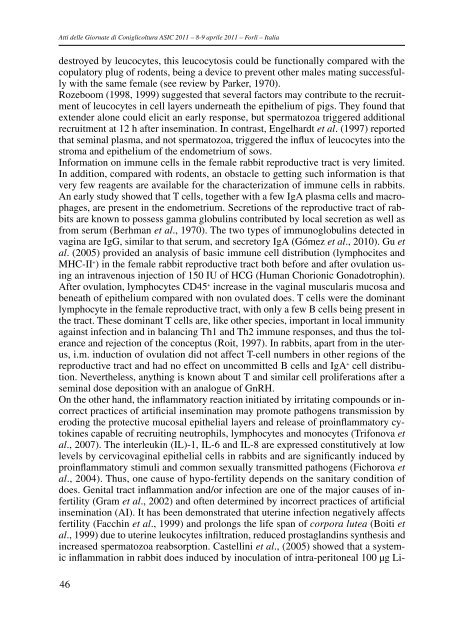atti delle giornate di coniglicoltura asic 2011 - Fondazione iniziative ...
atti delle giornate di coniglicoltura asic 2011 - Fondazione iniziative ...
atti delle giornate di coniglicoltura asic 2011 - Fondazione iniziative ...
You also want an ePaper? Increase the reach of your titles
YUMPU automatically turns print PDFs into web optimized ePapers that Google loves.
Atti <strong>delle</strong> Giornate <strong>di</strong> Coniglicoltura AsIC <strong>2011</strong> – 8-9 aprile <strong>2011</strong> – Forlì – Italia<br />
destroyed by leucocytes, this leucocytosis could be functionally compared with the<br />
copulatory plug of rodents, being a device to prevent other males mating successfully<br />
with the same female (see review by Parker, 1970).<br />
rozeboom (1998, 1999) suggested that several factors may contribute to the recruitment<br />
of leucocytes in cell layers underneath the epithelium of pigs. They found that<br />
extender alone could elicit an early response, but spermatozoa triggered ad<strong>di</strong>tional<br />
recruitment at 12 h after insemination. in contrast, engelhardt et al. (1997) reported<br />
that seminal plasma, and not spermatozoa, triggered the influx of leucocytes into the<br />
stroma and epithelium of the endometrium of sows.<br />
information on immune cells in the female rabbit reproductive tract is very limited.<br />
in ad<strong>di</strong>tion, compared with rodents, an obstacle to getting such information is that<br />
very few reagents are available for the characterization of immune cells in rabbits.<br />
an early study showed that T cells, together with a few iga plasma cells and macrophages,<br />
are present in the endometrium. secretions of the reproductive tract of rabbits<br />
are known to possess gamma globulins contributed by local secretion as well as<br />
from serum (berhman et al., 1970). The two types of immunoglobulins detected in<br />
vagina are igG, similar to that serum, and secretory iga (Gómez et al., 2010). Gu et<br />
al. (2005) provided an analysis of b<strong>asic</strong> immune cell <strong>di</strong>stribution (lymphocites and<br />
mhC-ii + ) in the female rabbit reproductive tract both before and after ovulation using<br />
an intravenous injection of 150 iu of hCG (human Chorionic Gonadotrophin).<br />
after ovulation, lymphocytes Cd45 + increase in the vaginal muscularis mucosa and<br />
beneath of epithelium compared with non ovulated does. T cells were the dominant<br />
lymphocyte in the female reproductive tract, with only a few b cells being present in<br />
the tract. These dominant T cells are, like other species, important in local immunity<br />
against infection and in balancing Th1 and Th2 immune responses, and thus the tolerance<br />
and rejection of the conceptus (roit, 1997). in rabbits, apart from in the uterus,<br />
i.m. induction of ovulation <strong>di</strong>d not affect T-cell numbers in other regions of the<br />
reproductive tract and had no effect on uncommitted b cells and iga + cell <strong>di</strong>stribution.<br />
nevertheless, anything is known about T and similar cell proliferations after a<br />
seminal dose deposition with an analogue of Gnrh.<br />
on the other hand, the inflammatory reaction initiated by irritating compounds or incorrect<br />
practices of artificial insemination may promote pathogens transmission by<br />
ero<strong>di</strong>ng the protective mucosal epithelial layers and release of proinflammatory cytokines<br />
capable of recruiting neutrophils, lymphocytes and monocytes (Trifonova et<br />
al., 2007). The interleukin (iL)-1, iL-6 and iL-8 are expressed constitutively at low<br />
levels by cervicovaginal epithelial cells in rabbits and are significantly induced by<br />
proinflammatory stimuli and common sexually transmitted pathogens (Fichorova et<br />
al., 2004). Thus, one cause of hypo-fertility depends on the sanitary con<strong>di</strong>tion of<br />
does. Genital tract inflammation and/or infection are one of the major causes of infertility<br />
(Gram et al., 2002) and often determined by incorrect practices of artificial<br />
insemination (ai). it has been demonstrated that uterine infection negatively affects<br />
fertility (Facchin et al., 1999) and prolongs the life span of corpora lutea (boiti et<br />
al., 1999) due to uterine leukocytes infiltration, reduced prostaglan<strong>di</strong>ns synthesis and<br />
increased spermatozoa reabsorption. Castellini et al., (2005) showed that a systemic<br />
inflammation in rabbit does induced by inoculation of intra-peritoneal 100 µg Li-<br />
46









